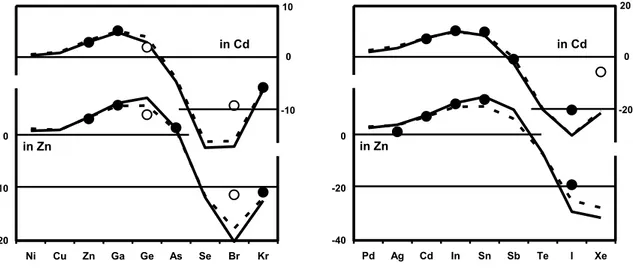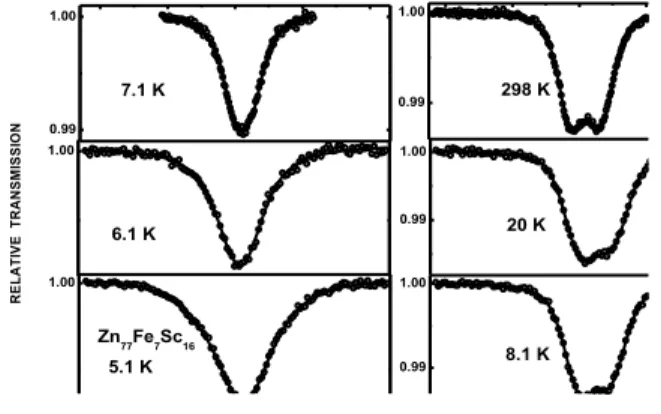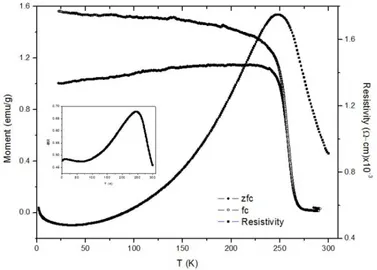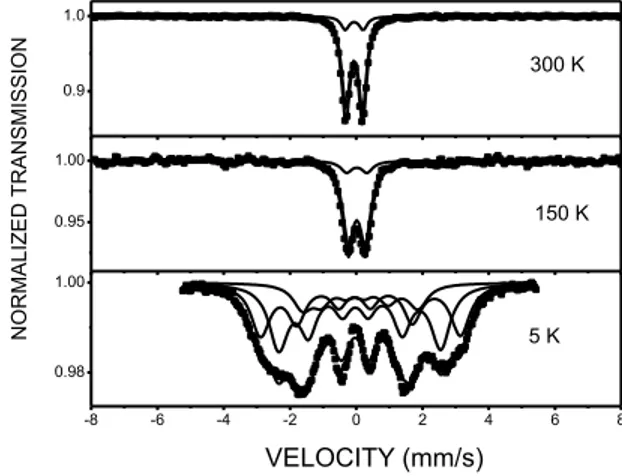Monday 13 September – 17 September 2010
2
CERN Entrance B
CERN hostels
Building 33
(main reception)
CERN Main
Restaurant (#1)
Y Bus Stop
CERN
Main Auditorium
56 Bus
Terminus
HFI2010: Guide to CERN
Magnetism and Magnetic materials - Bulk and thin layers Theory: Hyperfine Interactions, Nuclear Moments Semiconductors, Metals and Insulators
Biology, Chemistry, Medicine
Lattice Dynamics, Ion-Solid Interaction Surfaces, Interfaces, Thin Films, Nano-structures
Atoms and ions
Resonance Methods
Coherent Phenomena, Synchrotron Radiation, Quantum Optics Nuclear Moments/Polarization/Models, Fundamental
Interactions
New Directions and Developments in Methodology
Monday 13th Sept. Tuesday 14th Sept. Wednesday 15th Sept. Thursday 16th Sept. Friday 17th June
9:00-9:15 Welcome 9:00-9:20 Connell 9:00-9:20 MacFarlane 9:00-9:20 Klauss 9:00-9:20 Blaha
9:15-9:35 Nörtershäuser 9:20-9:40 9:20-9:40 9:20-9:40 9:20-9:40
9:35-9:55 9:40-10:00 Ko Mibu 9:40-10:00 Yoshida 9:40-10:00 Hemmingsen 9:40-10:00 Koch
9:55-10:15 Severijns 10:00-10:20 10:00-10:20 10:00-10:20 10:00-10:20 Haas
10:15-10:35 10:20-10:40 Alp 10:20-10:40 Panich 10:20-10:40 Petersen 10:20-10:40 Stone
10:35-10:55 Ohtsubo 10:40-11:10 coffee break 10:40-11:10 coffee break 10:40-11:10 coffee break 10:40-11:10 coffee break
10:55-11:25 coffee break 11:10-11:30 Sielemann 11:10-11:30 Sergueev 11:10-11:30 Correia 11:10-11:30 Kellö
11:25-11:45 Mangano/Lhc 11:30-11:50 11:30-11:50 11:30-11:50 Nagatomo 11:30-11:50
11:45-12:05 11:50-12:10 Molholt 11:50-12:10 Cadogan 11:50-12:10 Seliger 11:50-12:10 Zacate
12:05-12:25 Yuan 12:10-12:30 Carbonari 12:10-12:30 Wortmann 12:10-12:30 Furman 12:10-12:30 Haas/conclusion
12:25-14:00 lunch 12:30-14:00 lunch 12:30-14:00 lunch 12:30-14:00 lunch
14:00-14:20 Deicher 14:00-14:20 Saitovich Baggio- 14:00-14:20
C O N FE R EN C E TO U R 14:00-14:20 Asaji
14:20-14:40 Valentini 14:20-14:40 D. de Reotier 14:20-14:40 14:20-14:40 Poleshchuk
14:40-15:00 Munoz 14:40-15:00 Litterst 14:40-15:00 14:40-15:00 Hutchinson
15:00-15:20 Steffens 15:00-15:20 Salman 15:00-15:20 15:00-15:20 Goncalves
15:20-15:40 Butz 15:20-15:40 Mishra 15:20-15:40 15:20-15:40 Orlov
15:40-17:30 15:40-17:00 15:40-16:00 15:40-17:00
SESSION 1 POSTER POSTER
SESSION 2 16:00-17:30 POSTER SESSION 3
17:00-19:00 ISOLDE/SM18 17:00-19:00 ISOLDE/SM18 18:00-20:30 Conference
5
3
rd
Joint International Conference on
Hyperfine Interactions and International
Symposium on Nuclear Quadrupole
Interactions
CERN, Geneva, Switzerland
September 13-17 2010
cern.ch/hfi2010
6
Conference chairs
Krish Bharuth-Ram (Chair) Guido Langouche (Co-Chair)
Local Organizing Committee
Krish Bharuth-Ram Guido Langouche Reiner Vianden Manfred Deicher Wolf-Dietrich Zeitz Deena Naidoo Guilherme Correia Karl Johnston Yorick Blumenfeld Mats Lindroos
Jenny Weterings (ISOLDE Secretary)
Sylvie Padlewski (ISOLDE Secretary)
Program Committee
Reiner Vianden (Germany) Krish Bharuth-Ram (South Africa)
Ken Ichi Kumagai (Japan) Guido Langouche (Belgium)
Kensaku Matsuta (Japan)
Alberto F. Pasquevich (Argentina) Helena M. Petrilli (Brasil)
Gary Wulfsberg (USA)
Pierre Dalmas de Réotier (France) Wayne Hutchison (Australia) Heinz Haas (Switzerland)
Members of HFI/NQI Executive Committee
Krish Bharuth-Ram (South Africa)
Ken Ichi Kumagai (Japan)
Reiner Vianden (Germany) Guido Langouche
(Belgium)
Kensaku Matsuta (Japan)
Alberto F. Pasquevich (Argentina) Helena M. Petrilli (Brasil)
Gary Wulfsberg (USA)
7
International Advisory Committee
David Ailion (USA) Hisazumi Akai (Japan) Ercan Alp (USA) Tetsuo Asaji (Japan)
Tatyana Babushkina (Russia) Krish Bharuth-Ram (South Africa) EC (Chairman HFI/NQI2010) Aidan Byrne (Australia)
Gary S. Collins (USA)
Joao Martins Correia (Portugal) Stefaan Cottenier (Belgium) Manfred Deicher (Germany) Wayne Hutchison (Australia) Herbert Jaeger (USA)
Ryosuke Kadono (Japan) Ken Ichi Kumagai (Japan)
Guido Langouche (Belgium) Jochen Litterst (Brazil)
Karl Maier (Germany) Kensaku Matsuta (Japan) Tadanori Minamisono (Japan) Alberto F. Pasquevich (Argentina) Helena M. Petrilli (Brazil)
Mario Renteria (Argentina) John A. S. Smith (UK) Reiner Vianden (Germany) Pawel Wodniecki (Poland) Gary Wulfsberg (USA) EC Ilan Yaar (Israel)
Matthew Zacate (USA) Sheng-Yun Zhu (China) Jonathan Billowes (UK)
8
PREFACE
This is the third in the series of joint Conferences of the International Conference on Hyperfine Interactions and the International Symposium on Nuclear Quadrupole Interactions, and follows along the lines set at the first and second joint conferences at Bonn and Iguasu Falls in 2004 and 2007 respectively. An international Executive Committee (IEC) on Hyperfine Interactions was established at the meeting in Iguasu Falls, with Professor Reiner Vianden as its first Chair. The IEC was tasked with calling for nominations and managing the election of members of the International Advisory Committee (IAC) and the Program Committee of this conference.
After agreement among the Program Committee members, the topics to be discussed at the conference followed those of the previous conferences, and calls for nominations for Invited talks went out to the IAC, followed by the call for abstracts of proposed presentations from participants. Two Program Committee meetings were held at CERN, the first to agree on the Conference Program and to select the Invited Speakers, and the second to review the submitted abstracts and to select the Oral presentations. Of the 250 abstracts submitted initially a few were found not to fall within the ambit of a HFI/NQI conference.
The Organising Committee (LOC) met several times over the past two years. In this respect the initial contribution of Mats Lindroos on the do’s and don’t’s of organizing an international meeting at CERN was greatly appreciated, as were the continued efforts of Karl Johnston and Jenny Wetterings who together with Sylvie Padlewski formed a very effective and efficient conference secretariat. CERN has proved to be an excellent choice as venue of this conference, not only due to the excitement in the science community that news of LHC has generated, but especially because of the generous support we have received from the CERN management: the Director of CERN agreed to provide free accommodation in the CERN hostels for up to 50 students and participants from developing countries, as well as made available free of charge the CERN auditorium, committee rooms and poster space, while the ISOLDE Coordinator agreed to fund the appointment of the conference secretary. We were able to secure some support from the Abdus Salaam International Centre for Theoretical Physics (ICTP). We are very grateful for all the support, which allowed us to keep the registration fees as low as possible.
On behalf of the Organizing Committee, we wish to express our appreciation to all members of the International Advisory Committee and the Program Committee, and wish you all an intellectually challenging and socially enjoyable conference.
Krish Bharuth-Ram Guido Langouche
9
Monday 13 September 2010
Welcome – Main Auditorium (09:00-9:15)
Atoms And Ions - Main Auditorium (09:15-9:55)
Convener: VIANDEN, Reiner09:15 [27] Recent developments in Collinear Laser Spectroscopy at ISOLDE, CERN.
NOERTERSHAEUSER, Wilfried
Nuclear Moments, Nuclear Polarization, Nuclear Models, Fundamental
Interactions
- Main Auditorium (09:55-10:55) Convener: VIANDEN, Reiner09:55 [169] Recent Progress on Low Temperature Nuclear Orientation Technique and NMRON SEVERIJNS, Nathal
10:35 [124] NMR-ON study of 197PtNi OHTSUBO, Takashi
LHC - Main Auditorium (11:25-12:05) Convener: BLUMENFELD, Yorick
11:25 [179] THE LHC MANGANO, Michelangelo
NUCLEAR MOMENTS, NUCLEAR POLARIZATION, NUCLEAR MODELS, FUNDAMENTAL INTERACTIONS - Main Auditorium (12:05-12:25)
Convener: BLUMENFELD, Yorick
12:05 [35] Study of Dependence of Quasi-Particle Alignment on Proton and Neutron Numbers in A= 80 Region through g-factor measurements. ZHU, Shengyun, YUAN, Daqing
SEMICONDUCTORS, METALS AND INSULATORS - Main Auditorium (14:00-15:20)
Convener: HOFSäSS, Hans
14:00 [51] Donor-Acceptor Complexes in ZnO DEICHER, Manfred
14:20 [25] Angular correlation studies on 172Lu(172Yb) in GaN and measurement at low
Temperature VALENTINI, Riccardo
14:40 [59] PAC study of the dynamic hyperfine interactions at 111In-doped Sc
2O3 semiconductor and comparison
with ab initio calculations MUñOZ, Emiliano Luis RICHARD, Diego 15:00 [32] Temperature dependence of the hyperfine fields of 111In in sapphire (Al
2O3)
single crystals STEFFENS, Michael
NEW DIRECTIONS, NEW DEVELOPMENTS IN METHODOLOGY - Main Auditorium (15:20-15:40) Convener: HOFSäSS, Hans
15:20 [15] The concept of trajectories in the Data Analysis of Non-axially Symmetric Nuclear Quadrupole Interactions BUTZ, Tilman
10
POSTER SESSION - mezzanine (15:40-17:00)
ISOLDE/LHC TOUR - Main Auditorium (17:00-19:00)
Tuesday 14 September 2010
COHERENT PHENOMENA, SYNCHOTRON RADIATION, QUANTUM OPTICS – Main Auditorium (09:00-10:20) - Convener: DALMAS DE REOTIER, Pierre
09:00 [171] Quantum Diffusion of Muonium in Diamond CONNELL, Simon
09:40 [170] Investigations on thin Fe films and Heusler alloy films using synchrotron-radiation-based Mössbauer spectroscopy MIBU, Ko
NEW DIRECTIONS, NEW DEVELOPMENTS IN METHODOLOGY - Main Auditorium (10:20-10:40)
10:20 [86] Recent Methodological Developments in Nuclear Resonant Scattering with Synchrotron Radiation ALP, Esen Ercan
MAGNETISM AND MAGNETIC MATERIALS: BULK AND THIN FILMS - Main Auditorium (11:10-12:30) - Convener: LITTERST, Jochen
11:10 [151] Magnetism in Iron Implanted Oxides: A Status Report SIELEMANN, Rainer
11:50 [47] Mössbauer study of spin-lattice relaxations of dilute Fe3+ in MgO MøLHOLT, Torben
12:10 [137] Temperature dependence of the magnetic hyperfine field at 111Cd in ZnO doped
with Co CARBONARI, Artur
MAGNETISM AND MAGNETIC MATERIALS: BULK AND THIN FILMS - Main Auditorium (14:00-15:40) - Convener: GONçALVES, Joao
14:00 [130] Fe as Local Probe to follow the Competition between Magnetism and Superconductivity in the New Fe-pnictide Superconductors BAGGIO SAITOVITCH, Elisa
14:20 [76] Muon spin relaxation studies of geometrically frustrated magnets DALMAS DE REOTIER, Pierre 14:40 [46] Magnetism in Azurite Studied by Muon Spin Rotation LITTERST, Jochen
15:00 [97] Measuring the magnetic properties of monolayers of single molecule magnets SALMAN, Zaher 15:20 [36] Defect induced magnetic interaction in highly oriented pyrolytic graphite (HOPG): A local investigation
11
POSTER SESSION - Mezzanine (15:40-17:00)
ISOLDE/LHC TOUR - Main Auditorium (17:00-19:00)
Wednesday 15 September 2010
NEW DIRECTIONS, NEW DEVELOPMENTS IN METHODOLOGY - Main Auditorium (09:00-09:40) - Convener: GUNNLAUGSSON, Haraldur
09:00 [172] Beta detected NMR: a New Depth-resolved Probe of Materials at the Nanoscale
MACFARLANE, W. A.
SURFACES, INTERFACES, THIN FILMS, NANOSTRUCTURES - Main Auditorium (09:40-10:40) - Convener: GUNNLAUGSSON, Haraldur
09:40 [173] Development and applications of a Mössbauer camera YUTAKA, Yoshida 10:20 [3] Quadrupolar Perturbed NMR in Inorganic Nanomaterials PANICH, Alexander
LATTICE DYNAMICS, ION-SOLID INTERACTIONS - Main Auditorium (11:10-12:30)
Convener: MIBU, Ko
11:10 [174] Synchrotron radiation based TDPAC SERGUEEV, I.
11:50 [63] Phonon mode softening at the ferroelectric transition in EuxBa1-xTiO3 CADOGAN, Sean
12:10 [150] Density of Phonon States at the Fe Sites in Superconducting FeSe as Function of Temperature and Pressure WORTMANN, Gerhard
CONFERENCE EXCURSION - (14:00-22:00)
Tour of Annecy (France): 14:00-18:30
12
Thursday 16 September 2010
SEMICONDUCTORS, METALS AND INSULATORS - Main Auditorium (09:00-09:40)
Convener: MATSUTA, Kensaku
09:00 [175] MuSR studies of High Tc superconductivity in iron pnictides KLAUSS, H.
BIOLOGY, CHEMISTRY, MEDICINE, ARCHAEOLOGY, MINERALOGY - Main Auditorium (09:40-10:40) - Convener: MATSUTA, Kensaku
09:40 [176] Perturbed Angular Correlation in Bio Systems HEMMINGSEN, Lars
10:20 [128] Ab Initio Hyperfine Interactions as a Powerful Tool to Identify the Metal Binding Site in Biological Systems: Cd2+ in DNA Bases.DIVNA PETERSEN, Philippe Alexandre
RESONANCE METHODS - Main Auditorium (11:10-12:10)- Convener: EVENSON, Bill
11.10 Recent advances in emission channeling measurements and relevance to hyperfine interactions
CORREIA, J, Guillerme
11:30 [98] Precise Nuclear Moments of Extremely Proton-Rich Nuclei 23Al NAGATOMO, Takashi
11:50 [67] 14N NQR study of proton position and dynamics in some hydrogen bonded organic ferroelectrics
SELIGER, Janez
NEW DIRECTIONS, NEW DEVELOPMENTS IN METHODOLOGY - Main Auditorium (12:10-12:30) - Convener: EVENSON, Bill
12:10 [7] Entanglement in nuclear quadrupole resonance FURMAN, Gregory
BIOLOGY, CHEMISTRY, MEDICINE, ARCHAEOLOGY, MINERALOGY - Main Auditorium (14:00-14:20) - Convener: COTTENIER, Stefaan
14:00 [20] Proton Dynamics in One-dimensional Hydrogen-bonding System in Molecular Co-crystals TMP-D2ca and DMP-H2ca ASAJI, Tetsuo
THEORY - Main Auditorium (14:20-14:40) - Convener: COTTENIER, Stefaan
14:20 [1] DFT Study of Hyperfine Interactions in Some Types of the Complexes OLESHCHUK, Oleg
MAGNETISM AND MAGNETIC MATERIALS: BULK AND THIN FILMS - Main Auditorium (14:40-15:40) - Convener: COTTENIER, Stefaan
14:40 [90] Low Temperature Nuclear Orientation Studies of the Magnetic Structures of RNiAl4 in Applied Magnetic Fields HUTCHISON, Wayne
15:00 [155] Perturbed angular correlation study of the magnetic and structural first-order phase transition in MnAs GONçALVES, J. N.
13
15:20 [18] Anomalous Magnetism and 209Bi Nuclear Spin Relaxation in Bi 4Ge3O12
Crystals ORLOV, Valery
POSTER SESSION – Mezzanine (15:40-17:00)
CONFERENCE BANQUET – Cruise on Lac Leman (18:00-22:00)
Friday 17 September 2010
THEORY - Main Auditorium (09:00-10:40) - Convener: PETRILLI, Helena Maria
09:00 [95] Calculations of Hyperfine parameters in solids based on DFT and using WIEN2k BLAHA, Peter 09:40 [30] Electron penetration into the nucleus and its effect on the quadrupole interaction KOCH, Katrin
COTTENIER, Stefaan
10:00 [108] Quadrupole interaction in the solid halogens - a new (not final) look HAAS, Heinz 10:20 [146] A-priori calculations of hyperfine interactions in highly ionized atoms: g-factor
measurements of pico-second states populated in nuclear reactions. STONE, Nicholas
THEORY - Main Auditorium (11:10-11:50) - Convener: LANGOUCHE, Guido
11:10 [43] Electric field gradient calculations by quantum chemical methods KELLOE, Vladimir
SEMICONDUCTORS, METALS AND INSULATORS - Main Auditorium (11:50-12:10)
Convener: LANGOUCHE, Guido
11:50 [114] Modelling Complex Diffusion Mechanisms in L12-Structured Compounds ZACATE, Matthew
CONCLUSION - Main Auditorium (12:10-12:30)
14
Poster session I: Monday 13 September 15:40 –
17:00
THEORY
Poster # ID Title Primary Author
PS1-1 157 Density functional calculations of hyperfine parameters in manganites GONçALVES, J. N. PS1-2 4 Theoretical calculations on the Electric Field Gradient in HfO2:Cd and ZrO2:Cd TAYLOR, Marcela;
PS1-3 Moved to Thursday 16 September: Poster session 3
PS1-4 71 Electronic and structural properties of 181Ta in anatase and rutile: Experimental study and ab initio
calculations DAS, P
PS1-5 107 The EFG at sp-impurities in Zn and Cd - a new (final?) look HAAS, Heinz
PS1-6 118 Ab-initio hyperfine fields in Fe-Cr. SODRE, Ney
PS1-7 119 Ab initio study of the electronic structure and the EFG at Ta sites in HfO2:Ta & ZrO2:Ta. TAYLOR, Marcela Andrea
PS1-8 133 Ab initio calculations and PAC study of 111In-doped (Hf/Zr)
3Al2 and (Hf/Zr)4Al3 mixed compounds. EFG´s
and site preference ERRICO, Leonardo;
PS1-9 129 Electric Field Gradient and Electronic Properties of Crown Thioether Compounds NASCIMENTO, Rafael Rodrigues
MAGNETISM AND MAGNETIC MATERIALS: BULK AND
THIN FILMS
Poster # ID Title Primary Author
PS1-10 8 Investigation of hyperfine interactions in GdCrO3 perovskite oxide using PAC spectroscopy SAXENA, Rajendra
PS1-11 0 Mössbauer studies of the magnetic quasicrystal Zn77Fe7Sc16 NOWIK, Israel
PS1-12 13 Mössbauer and magnetic studies of (Mn, Zn)xCo1-xFe2O4 nanoferrites synthesized by using the citrate
precursor preparation technique MSOMI, Justice
PS1-13 19 Mössbauer spectroscopic study of the kinetics of sigma-phase formation in cold-rolled Fe-V alloys DUBIEL, Stanislaw PS1-14 23 Mössbauer and electrical studies of MnxCo1-xFe2O4 compounds prepared via glycothermal route ABDALLAH, Hafiz
PS1-15 24 Advances in a Bulk and Surface Properties Studies by using Mossbauer spectroscopy KAMZIN, Alexander PS1-16 33 Magnetic hyperfine field in the intermetallic compounds PrRh2Si2 and GdRh2Si2 measured with PAC
15
PS1-17 41 Perturbed Angular Correlations Investigations on Magneto-Electric Manganites MELO MENDONçA, Tânia PS1-18 44 Magnetic-Electronic Pressure Responase of Ilmenite (FeTiO3) SIBANDA, Wisdom Nkosilathi
PS1-19 45 Spin and Orbital Order in FeCr2S4 LITTERST, Jochen
PS1-20 62 Mössbauer Spectroscopy of the New Iron Oxide Fe3B7O13(OH) NAKAMURA, Shin
PS1-21 64 Magnetic and electrical transport properties of Ce/Ca substituted perovskite oxides SHARMA, M. P. PS1-22 79 Studies of GdZn compound magnetic properties using PAC spectroscopy with 140Ce and 111Cd as probe
nuclei SANTOS, Brianna
PS1-23 93 DyNi2Mn - Magnetisation and Mössbauer Spectroscopy CAMPBELL, Stewart
PS1-24 109 Magnetic Hyperfine Interaction of 59Fe in Nickel MUTO, Suguru
PS1-25 116 Magnetoelectric AgCrO2: A new local insight given by PAC DE PINHO OLIVEIRA, Goncalo
PS1-26 121 Investigations on FeSb2 by high field 57Fe Mössbauer spectroscopy REISSNER, Michael
PS1-27 123 Structural, electronic and magnetic properties of Ho substituted BiFeO3 as a function of temperature NAIDOO, Deena
PS1-28 125 A high temperature NMR study in optimally doped manganites PANOPOULOS, Nikos PS1-29 126 Incommensurate modulated spin order and NMR wipeout effect in electron-doped manganites probed by
139La NMR KOUMOULIS, Dimitrios
PS1-30 144 Magnetism in CaFe2As2 and Phase Separation in Superconducting Ba0.5K0.5Fe2As2 and Sr0.5Na0.5Fe2As2
Single Crystals: A Mössbauer Study SANCHEZ, Dalber
PS1-31 153 Magnetic and Electric Properties of Cadmium Films Containing Nanometer Size Clusters of Iron TRUJILLO, Wiliam PS1-32 156 Hyperfine local probe study of alkaline-earth manganites BaMnO3 and SrMnO3 GONçALVES, J. N.
PS1-33 161 Mössbauer and XPS studies of (Mn, Zn)xCo1-xFe2O4 ferrites DOLO, J. J.
PS1-34 166 Tin, Manganese doped chromium iron oxides of composition alpha-Sn0.2Cr1.8-xFexO3 and
alpha-Mn0.2Cr1.8-xFexO3
KALENGAY, Mbela
PS1-35 77 Paramagnetism in Mn/Fe implanted ZnO GUNNLAUGSSON, Haraldur
PS1-36 40 Absence of room temperature ferromagnetism in transition metal doped ZnO nanocrystalline powders from
PAC spectroscopy DOGRA, Rakesh
PS1-37 52 X-ray absorption and magnetic circular dichroism characterizations of Mo1-xFexO2 (x = 0 - 0.05) thin films
grown by pulsed laser ablation THAKUR, Pardeep Kumar
PS1-38 29 Features of Structural Transformations in La1-xCaxMn0.98Fe0.02O3+ (x = 0.05 - 0.50) SEDYKH, Vera
PS1-39 17 Experimental and theoretical study of the -phase in Fe-Cr and Fe-V alloys CIESLAK, Jakub PS1-40 141 Detection of sub-lattice magnetism in sigma-phase Fe-V compounds by zero-field NMR DUBIEL, Stanislaw M.
16
Poster session II Tuesday 14 Sept
SEMICONDUCTORS, METALS AND INSULATORS
Poster # ID Title Primary Author
PS2-1 26 Search for ferromagnetic ordering in Pd doped wide band gap semiconductors GaN and ZnO KESSLER, Patrick
PS2-2 28 Evidence of defect pairing for Pd-atoms in Germanium TIMMERS, Heiko
PS2-3 42 Oxygen ordering in the HgBa2CaCu2O6+ high-TC superconductor MELO MENDONçA, Tania
PS2-4 53 Perturbed gamma-gamma angular correlation studies of indium containing 211-MAX phases JUERGENS, Daniel PS2-5 55 Perturbed gamma-gamma angular correlation studies of indium free 211-MAX phases JUERGENS, Daniel
PS2-6 61 Experimental and ab initio study of Ta-doped ZnO semiconductor MUñOZ, Emiliano Luis; Mr. RICHARD, Diego
PS2-7 66 An In-defect complex as a possible explanation for high luminous efficacy of InGaN and AlInN based
devices KESSLER, Patrick
PS2-8 68 Precise calculation of semiconductor band gaps by means of the LDA-1/2 method FERREIRA, Luiz PS2-9 69 Study of annealing behavior of HfO2 fiber by hyperfine interaction technique. BANERJEE, D
PS2-10 70 Zr-doped Rutile TiO2: A Quadrupole Interaction Study BANERJEE, D
PS2-11 73 Search for "After-Effects" in Cd-doped ZnO semiconductor: PAC experiments supported by ab initio
results MUñOZ, Emiliano Luis
PS2-12 78 APW+lo and TDPAC study of the Electric-Field Gradient at the cation sites of the 44Ti(EC)44Sc-doped
Sc2O3 Semiconductor
RICHARD, Diego; Mr. MUñOZ, Emiliano Luis
PS2-13 81 Electronic and structural properties of the -Fe2O3:Ta semiconductor. Experimental EFG determination and
ab initio calculations. DARRIBA, Germán Nicolás
PS2-14 82 Experimental and ab initio study of the EFG at donor impurities in the Cr2O3:Ta semiconductor. DARRIBA, Germán Nicolás
PS2-15 94 Observation of iron impurities diffusion in silicon under bending stress by Mössbauer spectroscopy SUZUKI, Kunifumi PS2-16 100 Observation of long lived Fe3+ paramagnetic states in ZnO following the implantation with non-3d elements NAIDOO, Deena
PS2-17 104 TDPAC study of the phase transitions in PbTi1-xHfxO3 ALONSO, Roberto
PS2-18 115 Fitting TDPAC Spectra with Stochastic Models: PolyPacFit ZACATE, Matthew
PS2-19 117 Fluctuating Hyperfine Interactions: Computational Implementation EVENSON, William; ZACATE, Matthew PS2-20 139 Study of hyperfine interactions in CeO2 nanoparticle by PAC spectroscopy using 111Cd COSTA, Messias
17
PS2-22 142 Electric quadrupole interactions in nano-structured SnO2 as measured with PAC spectroscopy RAMOS, Juliana
PS2-23 143 Study of the electronic structure and electric field gradient at Cd probe in Co-doped ZnO matrix by first
principles calculations PEREIRA, Luciano
PS2-24 148 TDPAC study of a solid-state reaction doping process of 181Hf (181Ta) impurities in the Ho 2O3
semiconductor RICHARD, Diego
PS2-25 160 PAC study of the Si-HfO2 system subjected to high energy ball milling CHAIN, Cecilia Y.
PS2-26 162 Thermal Evolution of Short Range Order in Cu-Hf-Based Amorphous Alloys DAMONTE, Laura C. PS2-27 164 Dimensionless Coordinates for Simulations and Theory of Hyperfine Interactions in Materials EVENSON, William PS2-28 165 Defects studies in pure and doped In2O3 single crystals by PAC. QUILLE RAMOS, Ruben
PS2-29 60 Hyperfine parameters of Fe atoms in superconducting FeSe as function of temperature, pressure and
magnetic field. KSENOFONTOV, Vadim
PS2-30 12 Beta-NMR measurement of Cu-58 in Si MIHARA, Mototsugu
PS2-31 32 Temperature dependence of the hyperfine fields of 111In in sapphire (Al
2O3) single crystals STEFFENS, Michael
PS2-32 84 Nuclear electric quadrupole interactions of 111Cd in the heavy-fermion compound CeCoIn
5 FORKER, Manfred
NEW DIRECTIONS, NEW DEVELOPMENTS IN
METHODOLOGY
Poster # ID Title Primary Author
PS2-33 15 The Concept of Trajectories in the Data Analysis of Non-axially Symmetric Nuclear Quadrupole
Interactions BUTZ, Tilman
PS2-34 16 A User-friendly Fully Digital TDPAC-Spectrometer BUTZ, Tilman
PS2-35 21 Methodology of Quantitative Analysis in Mossbauer Spectroscopy IRKAEV, Sobir PS2-36 57 Lattice location of beryllium and boron, measured by thermal-neutron-induced emission channeling
measurements KöSTER, Ulli
PS2-37 112 Advantages of resonant detecting in hyperfine structure investigation by Moessbauer spectroscopy PANCHUK, Vitaly PS2-38 152 POLAREX : Study of polarized nuclei - first measurement GAULARD, Carole PS2-39 2 Air pollution studied by Mossbauer spectroscopy and synchrotron ZHANG, Guilin PS2-40 101 57Mn Implantation Mössbauer Spectroscopy of -Al2O3 by Anticoincidence Method KOBAYASHI, Yoshio
PS2-41 92 Kramers-degenerated Spin Systems “NV+n13C” in Diamond for Quantum Magnetometry:
18
Poster session III Thursday 16 Sept
BIOLOGY, CHEMISTRY, MEDICINE, ARCHAEOLOGY,
MINERALOGY
Poster # ID Title Primary Author
PS3-1 54 H/D Isotope Effect of 1H MAS NMR Spectra and 79Br NQR Frequencies in Piperidinium and
Pyrrolidinium p-Bromobenzoate HONDA, Hisashi
PS3-2 56 Variations of 57Fe Hyperfine Parameters in Medicaments Containing Ferrous Fumarate and Ferrous Sulfate OSHTRAKH, Michael
PS3-3 58 Measurements in DNA molecules using Perturbed Angular Correlation Spectroscopy SILVA, Andréia PS3-4 80 57Fe Quadrupole Splitting and Isomer Shift in Various Oxyhemoglobins: Study Using Mössbauer
Spectroscopy OSHTRAKH, Michael
PS3-5 91 Quantitative determination of phase transformations of the Tridymite-like FePO4 catalyst pre and post
oxidative dehydrogenation reactions to form Alkyl Methacrylates KHAN, Faiza PS3-6 113 Chemical states of 57Fe in rock salt type crystals arising from 57Mn KUBO, Kenya
PS3-7 120 Reduction of Amorphous Fe(III)-hydroxide by the Binary Microbial Culture, Mössbauer Study CHISTYAKOVA, Nataliya PS3-8 127 Electric Field Gradient and Electronic Properties of Crown Thioether Compounds NASCIMENTO, Rafael Rodrigues PS3-9 131 Beta-NMR as a novel technique using radioactive beams for biophysical studies STACHURA, Monika
PS3-10 136 Ab-initio study of copper complexes GONCALVES, Marcos
PS3-11 147 First Principles Electronic Structure Investigation of Order of Singlet and Triplet States of Oxyhemoglobin
and 57mFe Nuclear Quadrupole Interactions BADU, S. R.
PS3-12 159 Study of hafnium sodium salts of DTPA using PAC Spectroscopy CHAIN, Cecilia Yamil PS3-13 34 Negative thermal expansion and pressure induced amorphization in Zirconium tungstate as studied by 181Ta
TDPAC RAMANUJAM, Govindaraj
PS3-14 87 Structural Phase Transitions in a [Chloranilic Acid]-[2-Pyrrolidone] (1:2) Molecular Complex with
Hydrogen-Bond Networks MORIKAWA, Shota
PS3-15 135 Mössbauer characterisation of Copper ferrite as a model system for the Fischer-Tropsch synthesis CHONCO, Zandile; PS3-16 74 57Fe Hyperfine Interactions in M1 and M2 Sites of Olivine from Omolon Meteorite: Study Using
Mössbauer Spectroscopy PATRUSHEVA, Daria
PS3-17 85 14N NQR study of selected 1,4-benzoquinonedioximes SINGH, Nadia
PS3-18 11 Spectroscopic and mineral magnetic studies on some ancient pottery samples RAMDOSS, Venkatachalapathy PS3-19 49 Mössbauer Spectroscopic and Mineral Magnetic studies on Archaeological Potteries from Tamilnadu, India RAMDOSS, Venkatachalapathy PS3-20 10 Application of Mossbauer spectroscopy in investigation of wall rock alteration at uranium deposit LIN, Jun
19
LATTICE DYNAMICS, ION-SOLID INTERACTIONS
Poster # ID Title Primary Author
PS3-21 14 Debye temperature of sigma-phase Fe-V alloys DUBIEL, Stanislaw
PS3-22 48 Lattice Location and Diffusion of Interstitial Fe in MgO MøLHOLT, Torben Esmann PS3-23 72 Lattice sites of Fe in Al2O3 following implantation of 57Mn GUNNLAUGSSON, Haraldur
PS3-24 96 Mössbauer study of 57Fe in GaAs and GaP following 57Mn+ implantation MASENDA, Hilary
SURFACES, INTERFACES, THIN FILMS,
NANOSTRUCTURES
Poster # ID Title Primary Author
PS3-25 22 Investigation of Nanosized Magnetic Materials by SEDM Technique SEMENOV, Valentin PS3-26 37 Size effects on local magnetism of single Fe impurity in nano-crystalline noble metals: A TDPAD
investigation MISHRA, S.N.
PS3-27 38 Zr/Hf/Zr nanostructures studied by perturbed angular correlations LOPES, Armandina M.
PS3-28 39 Characterization of nanostructured HfO2 films using Perturbed Angular Correlation (PAC) technique DE MORAES CAVALCANTE, Fabio
Henrique
PS3-29 65 Temperature dependent studies of Zinc nanoferrite synthesized by spray pyrolysis MATHEW, Jacob; JACOB, Jess PS3-30 75 Electric field gradients in nanoparticles of HfAl2 and HfAl3 intermetallic compounds KULINSKA, Agnieszka
PS3-31 89 Laser Deposition of Iron on Graphite Substrates YAMADA, Yasuhiro
PS3-32 134 Investigation of hyperfine interaction in the nanostructured HfO2 by PAC spectroscopy ROSSETTO, Daniel
PS3-33 154 Study of nanoconfigurations in Zircon-Mullite composites using Perturbed Angular Correlations CHAIN, Cecilia Yamil PS3-34 158 Synthesis and characterization of nanoparticles of cobalt and nickel ferrites dispersed in mesoporous silicon
oxide BRAGA, Tiago;
PS3-35 163 Mössbauer spectroscopy and neutron diffraction study of the mechanosynthesis of nanocrystalline MgFe2O4 SEPELAK, V.
20
ATOMS AND IONS
Poster # ID Title Primary Author
PS3-37 145 Test of Variational Methods for Studying Hyperfine Interactions of Molecular and Solid State Systems by
Application to Atomic Systems PINK, R. H.
RESONANCE METHODS
Poster # ID Title Primary Author
PS3-38 5 Low Frequency Spin Echo in Multiple Pulse NQR Spin Locking KIBRIK, Gregory PS3-39 6 Phase transition and proton exchange in 1,3-diazinium hydrogen chloranilate monohydrate ASAJI, Tetsuo PS3-40 50 127I NQR and 1H NMR Studies of 4-Aminopyridinium Tetraiodoantimonate(III); Molecular Motion and
Phase Transition TERAO, Hiromitsu
PS3-41 83 Two and three frequency multipulse sequence for NQR of N-14 nuclei. MOZZHUKHIN, Georgy
PS3-42 102 35Cl NQR in glassy crystal, 2,5-dichlorothiophene FUJIMORI, Hiroki;
PS3-43 111 7Li quadrupole-perturbed NMR observation of biased Li-ion ordering in the paraelectric phase of weakly
substitutionally disordered K1-xLixTaO3
ZALAR, Boztjan
PS3-44 149 The cross-correlation effects in relaxation of quadrupolar nuclei in the multipolar spin systems KUPRIYANOVA, Galina PS3-45 105 Br NQR relaxation and successive phase transitions of CH3NH3HgBr3 NIKI, Haruo
21
NUCLEAR MOMENTS, NUCLEAR POLARIZATION,
NUCLEAR MODELS, FUNDAMENTAL INTERACTIONS
Poster # ID Title Primary Author
PS3-46 103 Magnetic Moment of Isomeric States in 175Ta KUMAR, Vivek
PS3-47 106 The quadrupole moments of Zn and Cd isotopes - an update HAAS, Heinz
PS3-48 122 Magnetic Moment of the 3/2+ State in 165Ho TANIGAKI, Minoru
PS3-49 99 Electric dipole moment search in 129Xe atom with an optical-coupling nuclear spin oscillator ASAHI, Koichiro
PS3-50 138 Polarization Creation in Proton-Rich 28P via Charge Exchange Reactions and Measurement of Its Electric
Quadrupole Moment MATSUTA, Kensaku
PS3-51 88 The nuclear quadrupole moment of the 245 keV excited state of 111Cd ERRICO, Leonardo Antonio
PS3-52 111 7Li quadrupole-perturbed NMR observation of biased Li-ion ordering in the paraelectric phase of weakly
substitutionally disordered K1-xLixTaO3
ZALAR, Bostjan
PS3-53 31 EFG calculations by the FPLO code KOCH, Katrin, COTTENIER, Stefaan
LATE-RECEIVED ABSTRACTS
PS3-54 181 First Principles Cluster Study of Electronic Structures, Locations and Hyperfine Interactions of Isolated
Atoms and Ions in Silicon PINK, R.H.
PS3-55 180 First Principles Study of Nuclear Quadrupole Interactions in Single and Double Chain DNA and Solid
Nucleobases BADU, S.R.
PS3-56 182 First Principles Study of Muonium Trapping and Associated Magnetic Hyperfine Interactions in
22
ORAL SESSIONS
Abstracts
23
Monday 13th September (9:15-9:55), Atoms and Ions
Recent developments in Collinear Laser Spectroscopy at ISOLDE, CERN
W Noertershaeuser1
1 University of Mainz, Germany
e-mail: wilfried.noertershaeuser@cern.ch
Optical spectroscopy is known to provide very accurate and model-independent data on spins, electromagnetic moments and charge radii of nuclear ground states. Collinear laser spectroscopy is long known to be a general technique, applicable to a large variety of elements, but was also developed continuously towards higher sensitivity and/or accuracy to scope with even more exotic species. At COLLAPS, the collinear laser spectroscopy setup at ISOLDE, we have applied a frequency-comb based technique to measure the charge radii of the beryllium isotopes including the one-neutron halo nucleus Be-11. Here, high accuracy was required and uncertainties in high voltage calibrations had to be eliminated by simultaneous spectroscopy in collinear and anti-collinear geometry. ISCOOL, a radio-frequency cooler and buncher came recently into operation and was for the first time applied at ISOLDE for the spectroscopy of copper and gallium isotopes and increased sensitivity by orders of magnitude. The isotope chains of both isotopes offered surprises concerning the spin values of the neutron-rich isotopes. Moreover, a new technique combining optical pumping and ß-asymmetry detection was applied for isotope shift shift measurements of Mg isotopes. In this way we were able to cover the chain of Mg isotopes across the complete sd shell to study the nuclear shape development during the transition into the island of inversion. In my talk I will present these methodological developments and the outstanding results that were obtained with these techniques at the COLLAPS experiment.
24
Monday 13th September (9:55-10:35), Nuclear Moments, Nuclear Polarization, Nuclear Models,
Fundamental Interactions
Recent progress with Low Temperature Nuclear Orientation and NMR/ON
Nathal Severijns
Instituut voor Kern- en Stralingsfysica, K.U.Leuven, Celestijnenlaan 200 D, B-3001 Leuven, Belgium, e-mail: nathal.severijns@fys.kuleuven.be
Recent results obtained in low temperature nuclear orientation (LTNO) and nuclear magnetic resonance on oriented nuclei (NMR/ON) experiments obtained with the different existing Nuclear Orientation setups will be reviewed and discussed.
These comprise nuclear moment measurements contributing to the study of nuclear structure in different regions of the nuclear chart, precision beta asymmetry parameter measurements to search for non-standard model components in the weak interaction, as well as solid state studies.
25
Monday 13th September (10:35-10:55), Nuclear Moments, Nuclear Polarization, Nuclear Models,
Fundamental Interactions
NMR-ON study of
197PtNi
T. Ohtsubo,1 S. Ohya1, Y. Masamori1, T. Izumikawa2, S. Muto3, K. Nishimura4 1 Dept. Phys. Niigata University, 2-8050, Ikarashi, Nishi-ku, Niigata, 950-2181, Japan, e-mail:
tohtsubo@np.gs.niigata-u.ac.jp
2 Radioisotope Center, Niigata University, Asahimachi-1, Niigata 951-8510, JAPAN 3 Neutron Science Laboratory, KEK, Tsukuba 305-0801, JAPAN
4 Faculty of Engineering, Toyama University, Toyama 930-8555, JAPAN
Nuclear magnetic resonance of oriented nuclei (NMR-ON) has been widely applied in the study of the electromagnetic properties of unstable nuclei and hyperfine interactions of dilute impurities in ferromagnetic metals. The hyperfine anomaly arises from the hyperfine interaction of the finite nuclear volume of nuclear magnetization and hyperfine field due to Fermi contact. The difference between the point nuclear magnetic structure and the finite magnetic structure is referred to as the Bohr-Weisskopf effect, which depends on the nuclear structure. In order to study the hyperfine anomalies of Pt isotopes, NMR-ON experiments on 197Pt in
Ni was measured.
Samples of 197PtNi were prepared with thermal neutron irradiation. Thin alloy foils of PtNi (0.1 at. % of
the 96% enriched 196Pt) were irradiated in the reactor at the Japan Atomic
Energy Research Institute. After irradiation, the sample was annealed in vacuum for 30 min at 800 °C and was cooled down to about 7 mK using a
3He/4He dilution refrigerator. The rays from 197Pt were measured by two
Si detectors mounted in the refrigerator at 0 and 180° with respect to the external magnetic field of 0.2, 0.4 and 0.6 T. NMR-ON spectra were observed by detecting the -ray asymmetry change with rf oscillating fields. Fig. 1 shows typical NMR-ON spectra of 197PtNi. For pure
magnetic interaction, the resonance condition is given by h = | g { Bhf +
(1+K)B0 } | N. From least-squares fits of the resonance frequencies vs the
external magnetic fields, the resonance frequency at B0 = 0 of 0(197PtNi)
= 230.7(1) MHz. Comparing with the magnetic resonance frequency of
191PtNi [1] and the magnetic moments determined by atomic beam method
[2], the hyperfine anomalies of Pt isotopes were deduced; 191 197 = 12(5) %. It is too large compared with the theoretical value (+0.2%). We also deduce the hyperfine anomaly with 195Pt [3,4] that has a same spin and
parity as 195 197 = 15(5)%. From these large values, the experimental
value of magnetic moment for 197Pt should be wrong.
References
[1] G. Seewald et al., Phys. Review B66, 174401 (2002).
[2] Y.W. Chan et al., Bull. Am. Phys. Soc. 13, No.6, 895 CE14 (1968). [3] M. Kontani and J. Itoh, J. Phys. Soc. Japan 22, 345 (1967) [4] W.G. Proctor and F.C. Yu Phys. Rev. 81, 20(1951)
Fig. 1. NMR-ON spectra of 197PtNi.
26
Monday 13th September (11:25-12:05), LHC
The LHC and its physics programme
Michelangelo Mangano1
1PH-TH Department, CERN, Route de Meyrin, 1211 Geneva 23, Switzerland michelangelo.mangano@mac.com
We review the outstanding issues in the understanding of elementary particles and their fundamental interactions, and illustrate the role of the Large Hadron Collider (LHC) in addressing them.
27
Monday 13th September (12:05-12:25), Nuclear Moments, Nuclear Polarization, Nuclear Models,
Fundamental Interactions
Study of Dependence of Quasi-Particle Alignment on Proton and Neutron Numbers in
A= 80 Region through g-factor Measurements
Yuan Daqing, Fan Ping, Zheng Yongnan, Zuo Yi, Zhou Dongmei, Zhang Qiaoli, Wu Xiaoguang, Li Guangsheng, Zhu Lihua, Xu Guoji, Fan Qiwen,
Zhang Xizhen and Zhu Shengyun**
China Institute of Atomic Energy, P.O. Box 275-50, Beijing 102413 Email: zhusy@ciae.ac.cn
The interplay between the collective rotation and the quasi-particle alignment is a significant feature of nuclear structure at high spins. The g-factors of intra-band high spin states of the ground rotational band can provide direct and unique information on quasi-particle alignment since the g-factors of the high-j proton and the high-j neutron are positively large and negatively small, respectively.
The g-factors of high spin states of the ground rotational band in 82Sr, 83Y, 84Zr, 85Nb, 85Zr and 86Zr have
been measured in order to study the dependence of quasi-particle alignment on the proton and neutron numbers.
The high spin states of the ground rotational band in 82Sr, 83Y, 84Zr, 85Nb, 85Zr and 86Zr were populated by
the fusion-evaporation reactions with the heavy ion beams from the HI-13 tandem accelerator at China Institute of Atomic Energy. The transient -magnetic-field ion implantation perturbed angular distribution (TMF-IMPAD) method was used to determine the g-factors of high spin states along the ground rotational band. The model calculations were also carrried out for some nuclides, which well reproduced the
experimentally measured g-factors.
The experimental results are shown in the above figure. It can be seen that for the nuclides 84Zr, 85Zr and 86Zr with Z=40 the proton alignment is followed by the neutron alignment in 84Zr and 85Zr, while the neutron
alignment is followed by the proton alignment in 86Zr, and for the nuclides 82Sr, 83Y, 84Zr and 85Nb with
N=44 the proton aligns only in 82Sr, the proton aligns first that is followed by the neutron alignment in 83Y and 84Zr and the neutron alignment is followed by the proton alignment in 85Nb. A discussion regard the
observed dependence will be presented.
28
Monday 13th September (14:00-14:20), Semiconductors, Metals and Insulators
Donor-Acceptor Complexes in ZnO
M. Türker 1, M. Deicher 1, H. Wolf 1, Th. Wichert 1, and the ISOLDE-Collaboration 2 1 Technische Physik, Universität des Saarlandes, D-66041 Saarbrücken, Germany
manfred.deicher@tech-phys.uni-sb.de 2 CERN, CH-1211 Geneva 23, Switzerland
One of the main obstacles to the technical application of many wide-gap semiconductors represents the difficulty to achieve reliable and sufficient p-type or n-type doping. Possible causes are the electrical compensation of dopants by native defects or other impurities present in the material. For the II-VI semiconductors CdTe, ZnTe, and ZnSe it has been shown [1,2] by perturbed angular correlation spectroscopy (PAC) that the concurrent presence of In donors and group-V acceptors leads to the formation of neighboring donor-acceptor pairs. In case of ZnO, the affinity to form donor-acceptor complexes may help to overcome the limitations of p-type doping of this material as outlined in the theoretically proposed concepts of cluster-doping [3] or co-doping [4].
Here, we report on PAC results obtained by co-doping experiments of ZnO using the donor 111In and different
group-V acceptors. Fig. 1 shows a PAC spectrum obtained after the implantation of ZnO with 111In and P and after annealing
at 850 K. Besides the lattice electric field gradient (EFG) due to the wurtzite structure of ZnO ( Q Lattice = 31 MHz),
two additional EFG caused by the formation of In-defect complexes are observed. They are characterized by two slightly different nearly axially symmetric EFG with Q1 = 175(1) MHz ( = 0.1) and Q2 = 155(2) MHz ( = 0). Due
to the wurtzite structure of ZnO having different nearest neighbor distances along the c axis and in the basal plane, respectively, even for identical defect complexes two different EFG are expected to occur. The magnitudes of the EFG observed here are similar to that of the EFG known for In-acceptor complexes in other II-VI semiconductors [1,2]. The nature of the defects in ZnO and the efficiency of different co-doping procedures will be discussed.
Fig. 1: PAC spectrum (left) and its Fourier transform (right) of ZnO doped with In and P by ion implantation and annealed at 900 K. The measurement was performed with the c-axis perpendicular to the detector plane. The results of first PAC experiments on the formation of donor-acceptor complexes using group-VII donors in ZnO utilizing the radioactive donor 77Br will be discussed, as well.
This work has been supported by the Bundesministerium für Bildung und Forschung (BMBF) under contract no. 05KK7TS1.
[1] V. Ostheimer, A. Jost, T. Filz, St. Lauer, H. Wolf, and Th. Wichert, Appl. Phys. Lett. 69, 2840 (1996). [2] S. Lany, P. Blaha, J. Hamann, V. Ostheimer, H. Wolf, and Th. Wichert, Phys. Rev B 62 R2259 (2000). [3] L.G. Wang and A. Zunger, Phys. Rev. Lett. 90, 256401 (2003).
[4] T. Yamamoto and H. Katayama-Yoshida, Physica B 302-303, 155 (2001).
0 100 200 300 0.05 0.00 -0.05 -0.10 t (ns) R (t) 0 200 400 600 0 1 2 Q2 (Mrad/s) Fo uri er a m plitu de Q Lattice Q1
29
Monday 13th September (14:20-14:40), Semiconductors, Metals and Insulators
Angular correlation studies on
172Lu(
172Yb) in GaN and measurement at low
temperature
Riccardo Valentini and Reiner Vianden
Helmholtz – Institut für Strahlen- und Kernphysik der Universität Bonn, Nußallee 14-16, 53115 Bonn, Germany, e-mail: riccardo.valentini@hiskp.uni-bonn.de
For optoelectronic devices semiconductors with large band gap doped with rare earth are used. Doping is generally performed during growth but for more structured doping the ion implantation technique is preferable. The perturbed γγ-angular correlation technique is an ideal tool to study the annealing behavior of semiconductors after implantation. Usually, this method is only able to measure the absolute value but not the sign of the electrical field gradient (EFG) acting onto the quadrupole moment of the implanted probe. An adequate rare earth isotope for such investigations of semiconductors is 172Yb.
The temperature dependence of the hyperfine fields for 172Lu(172Yb) in GaN has been analyzed. The total EFG at
the site of this probe is a superposition of the lattice EFG due to the GaN wurtzite structure and the EFG due to the 4f-shell of the rare earth probe itself. The latter is strongly temperature dependent and opposed to the lattice EFG which in contrast is nearly constant since the lattice parameters change only negligibly with temperature. At elevated temperatures all crystal field split levels of the 4f-shell are equally populated. But at low temperatures the lowest level is occupied preferentially. Sign and magnitude of the EFG produced by the 4f shell can be calculated [1]. Depending on which of the levels is lowest in energy it was possible to determine the sign of the lattice field gradient.
References
[1] K.Tomala et al., Journal of Magnetism and Magnetic Materials 89, 143-152 (1990).
Fig. 2. Splitting of the 4f shell with positive lattice EFG. Fig. 1. Splitting of the 4f shell with negative lattice EFG.
30
Monday 13th September (14:40-15:00), Semiconductors, Metals and Insulators
PAC study of the dynamic hyperfine interactions at
111In-doped Sc
2
O
3semiconductor
and comparison with ab initio calculations
E. L. Muñoz1, D. Richard1, A. W. Carbonari2, L. A. Errico1 and M. Rentería1.
1Departamento de Física e Instituto de Física La Plata (IFLP, CCT La Plata, CONICET-UNLP), Facultad de Ciencias Exactas, Universidad Nacional de La Plata, CC 67, 1900 La Plata, Argentina,
e-mail:munoz@fisica.unlp.edu.ar
2 Instituto de Pesquisas Energéticas y Nucleares-IPEN-CNEN/SP, São Paulo, Brazil
The combined experimental and theoretical approach based on electric-field gradient (EFG) determinations by means of hyperfine interaction measurements and ab initio predictions at impurity atoms has been shown to be a powerful tool to unravel structural and electronic characterizations of impurities in solids, in particular in semiconductor oxides [1-3]
In this work, PAC experiments using 111In-difussed Sc
2O3 polycrystals have been performed at the IPEN facility in
order to measure the Electric-Field Gradient (EFG) at (111In (EC)) 111Cd nuclei located at the cation site of the
semiconductor lattice. The experimental results are compared with ab initio calculations performed with the Full-Potential Augmented Plane Wave plus local orbital (FP-APW+lo) method in the framework of the Density Functional Theory (DFT).
The PAC experiments were carried out in the temperature range 10 K – 900 K. The PAC spectra obtained in these measurements shows two very well-defined quadrupole frequencies along the whole temperature range, pointing to the fact that 100% of the probes are located at both nonequivalent cation sites of the bixbyite structure. Nevertheless, the spectra are dampened at certain intermediate temperatures, indicating the presence of dynamic hyperfine interactions that were analyzed with a perturbation factor based on the Bäverstam and Othaz model [4,5]. The FPAPW+lo calculations were performed using the Wien2K code.
From the ab initio-experimental comparison, we can conclude that the Cd impurities localized at the axially symmetric D sites of the crystal structure do not present dynamic interactions while that the Cd probes localized at the asymmetric C sites present appreciable dynamic interactions attributed to the so-called after-effects that follow the electron-capture decay of the 111In parent isotope of the 111Cd impurity tracer. This scenario could be supported in
terms of the EFG behaviour, predicted by the ab initio calculations, at Cd impurities as a function of the charge state of the impurity located at the different cation sites of the structure.
References
[1] Anisotropic Relaxations Introduced by Cd Impurities in Rutile TiO2: First-Principles Calculations and Experimental Support L.A. Errico, G.
Fabricius, M. Rentería, P. de la Presa, and M. Forker. Physical Review Letters 89, 55503 (2002).
[2] Metal Impurities in an Oxide: Ab Initio Study of Electronic and Structural Properties of Cd in Rutile TiO2
L.A. Errico, G. Fabricius, and M. Rentería. Physical Review B 67, 144104 (2003).
[3] Metal Impurities in an Oxide: Ab Initio Study of Electronic and Structural Properties of Cd in Rutile TiO2
G. N. Darriba, L. A. Errico, P. D. Eversheim, G. Fabricius, and M. Rentería. Physical Review B 79, 115213 (2009).
[4] U. Bäverstam, R. Othaz, N. De Sousa and B. Ringström, Nucl. Phys. A186, 500 (1972). [5] A. Abragam and R. V. Pound, Phys. Rev. 92, 943 (1953).
31
Monday 13th September (15:00-15:20), Semiconductors, Metals and Insulators
Temperature dependence of the hyperfine fields of
111In in sapphire (Al
2
O
3) single
crystals
Michael Steffens,1 Jakob Penner1, Hassan Kamleh2, Reiner Vianden1
1 Helmholtz-Institut für Strahlen- und Kernphysik, Universität Bonn, Nußallee 14-16, 53115 Bonn,
e-mail: steffens@hiskp.uni-bonn.de
2 Department of physics, Faculty of Sciences, University of Damascus, Syria
The decay of 111In to 111Cd via electron capture, accompanied by Auger electrons, leaves the outmost atomic
shell of the Cadmium in a highly ionized state.
In PAC measurements, this so called “electron capture after effect” leads to a significant loss of anisotropy and can be associated with a highly fluctuating electric field gradient (EFG).
The recovery of the 111Cd shell by electronic recombination depends on the concentration and the mobility
of charge carriers in the material. For insulators, the recombination timescale lies in the nanosecond regime, the generic timescale of hyperfine interaction processes as investigated by the PAC method.
In previous measurements the fraction of undisturbed probe atoms showed a strong and reversible dependence on the sample temperature [1].
Our current approach is to determine and alter the conditions under which electrons are sufficiently available to suppress the “after effect”.
Sapphire single crystals were ion implanted with 111In at the mass separator in Bonn. After rapid thermal
annealing the samples were held at temperatures up to 1000 K. To alter the recombination characteristics and to study the influence of acceptor and donator levels, the samples were additionally doped with several concentrations of Si, Cr and P.
References
32
Monday 13th September (15:20-15:40), Semiconductors, Metals and Insulators
The Concept of Trajectories in the Data Analysis of Non-axially Symmetric Nuclear
Quadrupole Interactions
Tilman Butz1
1 University of Leipzig, Germany, e-mail: butz@physik.uni-leipzig.de
The nuclear quadrupole interaction is described as the product of the nuclear quadrupole moment Q with the electric field gradient (EFG) tensor. This is a symmetric, trace-less 3x3 tensor which usually is described by two quantities in the principle coordinate system: the largest component by magnitude is denoted by Vzz and
the asymmetry parameter is defined as h = (Vxx – Vyy)/Vzz. Frequently, these two quantities are determined
for powder samples as a function of an external variable, e.g. temperature. It is customary to plot both quantities separately versus temperature. This, however, masks any eventual interdependencies of the two quantities. A better way to plot the results is to plot Vzz and Vxx in a cartesian plot, or better in a Czjzek-plot
[1], a variant of the cartesian plot, which is still linear in both variables. Each data pair of Vzz/Vxx constitutes
a point in this plot with temperature being the implicit parameter. Connecting all points by a continuous line yields a trajectory. This trajectory is continuous even when passing over h = 1 where the tensor orientation flips by 90° and the sign of Vzz changes.
Interestingly enough, there are many examples where a straight trajectory is observed, i.e. both variables depend linearly on each other. This can be modelled by a linear superposition of two tensors which are simultaneously diagonal and temperature independent:
V = V1 + a(T)V2.
The only temperature dependent quantity is a(T), the control parameter. In this situation it is clear that fitting 2n independent parameters for n temperature points is wrong. Instead, a scale factor and a slope should be fitted in addition to n values for a(T), i.e. there are n+2 independent parameters only. The slope is given by the asymmetry parameter of V2, which is the asymptotic asymmetry parameter of V for large a. V2 must have a physical interpretation, contrary to V1 which can be modified by shifting a (unless we know where a must be 0, i.e. if a is an order parameter). The temperature dependence of a contains all solid state information like lattice expansion, lattice vibrations, and changes in the electronic charge density distribution.
The correct strategy for the data analysis would be to analyze the data conventionally, plot the data in the Czjzek-plot, and for a straight trajectory perform a simultaneous fit of all data with n+2 adjustable parameters in a second tier.
Another interesting class of systems can be described by a linear superposition of two tensors which are not simultaneously diagonal in the same principle coordinate system but which share one common coordinate around which the other two rotate. In other words, only a 2x2 matrix has to be diagonalized. The structure of the resulting eigenvalues (Vieta’s formula) is such that by using the sum and the product of both the control parameter can be eliminated straightforwardly and second order curves result which must be hyperbolae because we require asymptotes. In this case we require n+3 adjustable parameters, i.e. a scale factor, the asymptotic asymmetry parameter and one off-diagonal element which describes the rotation in addition to n values for a. Again, a simultaneous fit of all data is required in a second tier.
Examples of experiments with linear and hyperbolic trajectories will be given. References
33
Tuesday 14th September (9:00-9:40), Coherent Phenomena, Synchrotron Radiation, Quantum Optics
MSR in diamond
SH Connell1, K Bharuth-Ram2 and SFJ Cox3
1 Department of Physics, University of Johannesburg, University Road, Johannesburg 2006, South Africa, e-mail:
shconnell@uj.ac.za
2 School of Physics, Univ. of KwaZulu-Natal, Durban 4041, South Africa, e-mail: kbr@tlabs.ac.za 3ISIS Facility, Rutherford Appleton Lab, Chilton, Oxfordshire, OX110QX, UK, e-mail: S.F.J.Cox@rl.ac.u
Diamond as a material has evolved beyond its roles as a gem or an abrasive to find a niche in modern high technology areas. Examples include radiation detectors, electronic devices, biosensors, X-ray optics and also a promising system for the realization of quantum communication and computation. The reason for the development of these new applications is that the parameters describing the electronic and physical properties of diamond usually represent very extreme values. Indeed, diamond vertex detectors are being considered for the upgrade of some of the LHC experiments. It has recently become possible to take advantage of the interesting properties of diamond, as the synthesis of diamond has reached a point that material with impurities below the part per billion range and residual strain in the order of ten nano-radians has been realized. Hyperfine interactions have played a key role in the study of diamond and the emergence of novel applications. This relates to the characterization of defects and the development of engineered few spin systems. A particular aspect of the defect studies is the elusive hydrogen defect. In MSR studies, muonium is considered a light “isotope” of hydrogen with very similar chemical properties, but with very interestingly different dynamical properties, due to its much lighter mass. It offers a unique opportunity to study the behaviour of hydrogen in diamond at very low concentrations. The studies have revealed details of the elementary muonium atom as well as a molecule involving muonium in the diamond lattice. The dynamics of the muonium, which include quantum diffusion and ionization have also been studied. This contribution reviews MSR in diamond in the context of diamond as a modern material hosting advanced applications.
34
Tuesday 14th September (9:40-10:20), Coherent Phenomena, Synchrotron Radiation, Quantum Optics
Investigations on thin Fe films and Heusler alloy films using
synchrotron-radiation-based Mössbauer spectroscopy
Ko MIBU1
1Nagoya Institute of Technology, Japan
Recent development in synchrotron-radiation-based nuclear resonant scattering or Mössbauer spectroscopy has opened up new aspects on investigation of materials in the measurements of hyperfine interactions and also of local phonon density-of-states. In Japan a five-year project led by Prof. Seto at Kyoto University is now in progress for further development of these unique techniques. The field of magnetic thin films is also getting a benefit from these new techniques through detection of magnetic hyperfine fields. The method which has mainly been used so far for thin film experiments is "time domain" measurements, where interference patterns of pulsed X-rays resonantly scattered by nuclei are detected as a function of time. However, "energy domain" measurements are more desirable for thin films, which often contain inhomogeneity in the nuclear environments. In our project, a new synchrotron-radiation-based "energy domain" Mössbauer spectroscopic method has been developed, and optimized also for investigations on magnetic thin films. In this presentation, the validity and limitations of this method are demonstrated by showing some experimental results on thin Fe films and Heusler alloy films.
35
Tuesday 14th September (10:20-10-40), New Directions and Developments in Methodology
Recent Methodological Developments in Nuclear Resonant Scattering with
Synchrotron Radiation
Esen Ercan Alp,1 Thomas Toellner1, Wolfgang Sturhahn1, Jiyong Zhao1
1 Argonne National Laboratory, USA
e-mail: alp@anl.gov
The year 2010 marks the 25th anniversary of the first successful demonstration of nuclear resonant scattering using synchrotron radiation. During this period, many different experimental approaches have been developed to observe and conduct meaningful scientific experiments in samples of mineralogical and biological interest. Among these, we can distinguish the development of high-resolution, tunable crystal monochromators, back-scattering crystals, polarization-based optics, interferometric techniques, and creation of of single-line absorbers for direct energy-domain measurements. Some of these are implemented for some subset of the dozen or so different Mossbauer isotopes with transition energies ranging from 6 to 70 keV. Currently, at least 5 different synchrotron beamlines are dedicated fully or partially for this purpose. Some of these facilities, like Sector 3-ID at the APS will be upgraded soon, while some newer facilities are also just coming on-line, like PETRA-III. We will to review the progress made at the APS and the upgrade plans for the 3-ID, the only dedicated beamline in the USA.
36
Tuesday 14th September (11:10-11:50), Magnetism and Magnetic Materials – Bulk and Thin Layers
Magnetism in Iron Implanted Oxides: A Status Report
R. Sielemann1 and the Mössbauer Collaboration at ISOLDE/CERN2
1Helmholtz-Zentrum Berlin für Materialien und Energie, D-14109 Berlin, Germany
sielemann@helmholtz-berlin.de
2PH Dept. ISOLDE/CERN, 1211 Geneva 23, Switzerland
Diluted magnetic semiconductors form a special class of magnetic materials which has drawn a lot of attention over the last years both for the interest in the basic physics involved and for possible applications, e.g., in the field of spintronics. However, there is no general agreement on the origin of this type of magnetism. Various coupling mechanisms between the magnetic ions have been proposed, in addition the role of intrinsic defects as well as of unintentional magnetic impurities and precipitations was considered. Oxides with embedded magnetic ions form a subclass of the magnetic semiconductors. To study magnetism at the atomic level Mössbauer spectroscopy (MS) can be utilized, especially with 57Fe. Since the solubility
of 3d magnetic ions in most semiconductors is small, their introduction is difficult. So, implantation is a favorable technique. In addition it creates intrinsic defects and thus may influence (create) magnetic phenomena. With this idea in mind 57Fe MS was performed at the ISOLDE facility at CERN following
implantation of radioactive 57Mn (T
1/2 = 1.5 min) in diverse oxides with a focus on ZnO, one of the most
important materials for magnetic semiconductors [1]. The Mössbauer spectra obtained consist to a large part of a magnetic sextet with splitting up to about 50 T and in addition of nonmagnetic components indicating different lattice sites and/or charge states of the Fe atoms. Surprisingly the sextet persists up to measuring temperatures of about 600 K. Experiments performed on other oxides (e.g., MgO, Al2O3) show results with
partly similar and partly differing features. Detailed MS studies as function of temperature, implanted Mn concentration, pre-doping of the oxides with various magnetic and nonmagnetic ions and in particular experiments with an external magnetic field of 0.6 T show a variety of phenomena with respect to the occurrence of the magnetic fraction and permit attributing it to Fe-ions in a 3+ paramagnetic state. This
observation of a static magnetic pattern is enabled by the unusually long relaxation time > 20 ns even at 600 K though this relaxation time normally strongly decreases with rising temperature. Unlike a first report [2] there is presently no necessity to involve ordered magnetism in the interpretation of the magnetic spectra [3]. The assets of MS in these studies compared to, e.g., the EPR technique (Electron Paramagnetic Resonance) will be discussed.
References
[1] T. Dietl et al., Science 287, 1019 (2000).
[2] G. Weyer et al., J. Appl. Phys. 102, 113915 (2007).
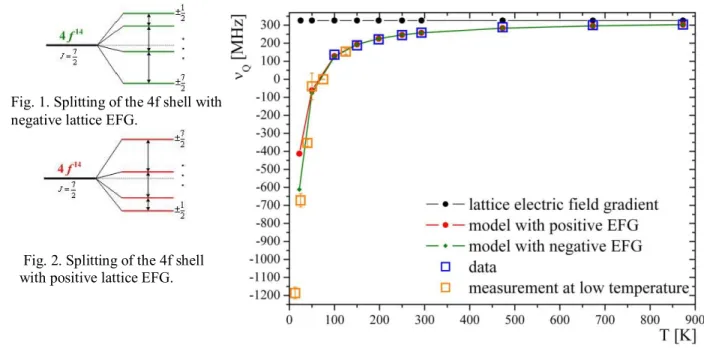
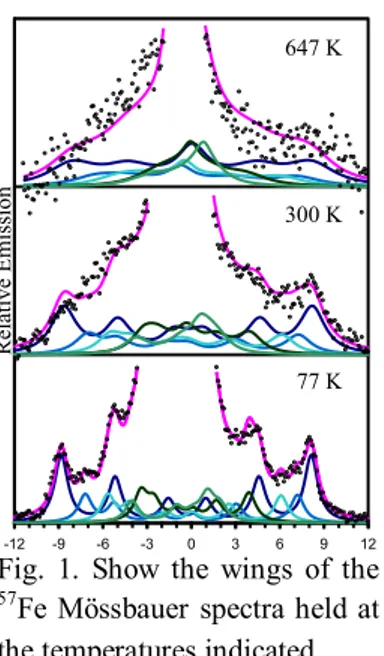
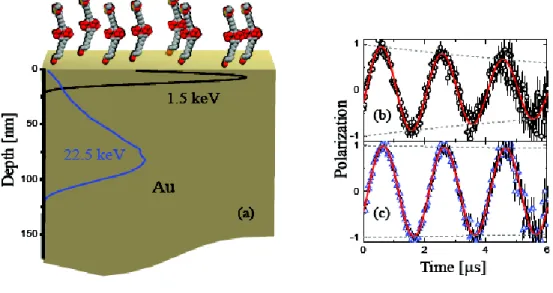
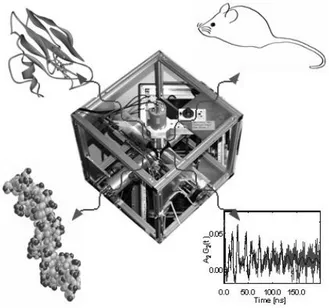
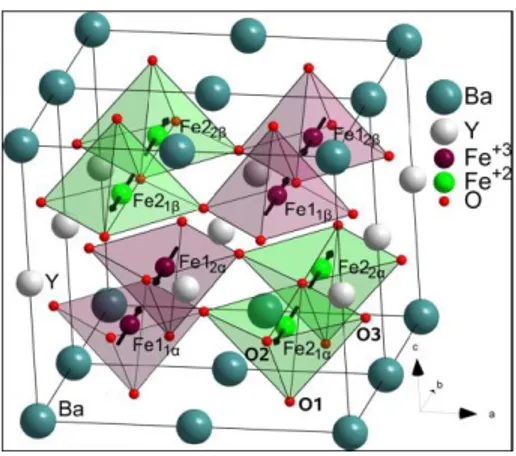
![Fig. 1. Calculated and measured [4] attenuation coefficients for Pd, Ru and Mo ions](https://thumb-eu.123doks.com/thumbv2/5dokorg/3954328.76564/65.893.308.568.670.860/fig-calculated-measured-attenuation-coefficients-pd-ru-ions.webp)
